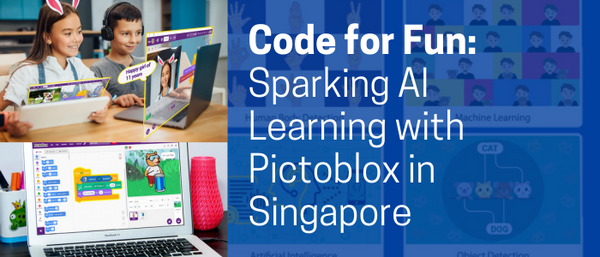50 Cool AI and Machine Learning Projects for Students
Coding and programming have become part of the staple for schools around the world .
Now, there are even more platforms to help students below 16 years old create models and projects that are closer to systems and concepts used in real life, such as projects that utilise Machine Learning and Artificial Intelligence.
We understand how projects with new and relatively complex technology may be intimidating.
We have found 50 project ideas to help you get started on your Machine Learning and Artificial Intelligence learning journey!
Have a look at these cool ideas you can start creating in your free time or for school projects.
1) Dish Classifier (11 years old and above)

Source:https://aiyprojects.withgoogle.com/model/food-detector-classifier/
It uses the MobileNet model architecture to recognize over 2,000 different types of food. The Dish Classifier model is designed to identify food in images.
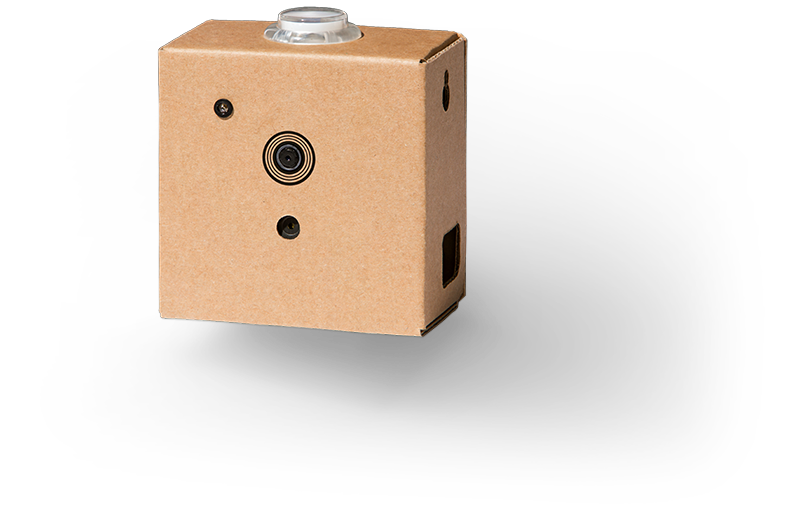
Platform/Tool: Google AIY Vision Kit
2) Handwritten Digit Recognition using Python (10 - 15 years old)

Source: https://data-flair.training/blogs/python-deep-learning-project-handwritten-digit-recognition/
A computer's capability for recognizing handwritten digits is called handwritten digit recognition. However, machines may find it difficult to recognised handwritten numbers because handwritten digits are not perfect and each person will have their own way of writing numbers. This problem can be solved with handwritten digit recognition, a technique that uses a digit image to identify the digits contained in the image.
This idea works great for projects that may require you to digitise handwritten documents like mail or old physical forms in an office.
This project is also recommended to more advanced student coders who are ready to try simple Python projects.
Platform/Tool: Python
3) Lane Line Detection (6 to 10 years old)
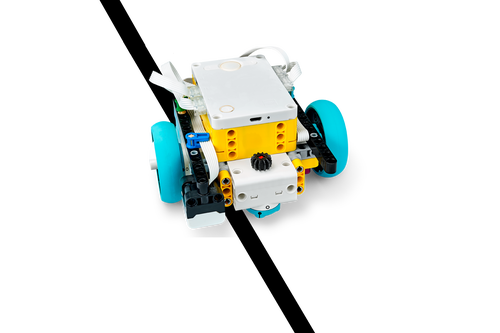
Source: https://education.lego.com/en-au/lessons/prime-competition-ready/training-camp-3-react-to-lines
Source: https://www.youtube.com/watch?v=le1adXB3dYs&ab_channel=YoshihitoISOGAWA
You will be able to program their Driving Base to stop at the black line, and optimize the program for speed of the car, how cool is that!
Platform/Tool:
- LEGO Education SPIKE Essential (5 - 10 years old) or LEGO Education SPIKE Prime (10 years old and above)
- SPIKE App (Coding Platform)
4) Game of Chess (15 years old and above)
Create a game of chess that is challenging to humans by using a sophisticated artificial intelligence system!
Sounds impossible and don't know where to start? Here's a video to guide you!
Source: https://www.youtube.com/watch?v=DZfv0YgLJ2Q&ab_channel=CodeBullet
Platform/Tool: Javascript
5) Virtual Doctor (10 years old and above)
An apple a day keeps the doctor away! In this AI and ML project, you'll learn how to make a virtual doctor by using PictobBlox.
Source: https://www.youtube.com/watch?v=72tU1PMK5Sk&ab_channel=STEMpedia
For more information, do check out this link!
STEMpedia - https://thestempedia.com/project/virtual-doctor-using-nlp-extension-in-pictoblox/
Platform/Tool: PictoBlox
6) Gesture-Controlled Space Battle Game (10 years old and above)
Space Battle is an AI-based game that you can control only by hand gestures. Can you beat your own game?
Source: https://www.youtube.com/watch?v=WBccow6pqHQ&ab_channel=STEMpedia
Platform/Tool: PictoBlox
7) Smart AI Chatbot (10 years old and above)
Using PictoBlox's Speech Recognition extension, the chatbot will recognize speech patterns and convert it into text to answer your questions. Sounds similar to Siri and Alexa!
Source: https://www.youtube.com/watch?v=syTRZsn37Vg&ab_channel=STEMpedia
Platform/Tool: PictoBlox
8) Make Face Filters Using Face Detection (10 years old and above)
Students learn to use the camera to detect their face and to fit a filter to their face according to their facial motions using artificial intelligence. It even adjust the tilt of the filter to match their face tilt.
Source generated: https://www.youtube.com/watch?v=bRGwMWoNkec&ab_channel=STEMpedia
Platform/Tool: PictoBlox
9) Gesture Controlled Flappy Bird Game (10 years and above)
You have to move your head around in order to guide the bird, which follows the tip of your nose. The game uses artificial intelligence to analyze your nose through the camera, which then drives the bird's movements.
Watch the video below for a clearer understanding:
Source: https://www.youtube.com/watch?v=07fN-izABRI&ab_channel=STEMpedia
Platform/Tool: PictoBlox
10) Toy Recognizer (10 years and above)
In this game, you train the computer to recognize your toys and then speak their names when you bring them in front of the camera. This is a machine learning subset of AI that learns what is what from previously loaded samples.
Source: https://www.youtube.com/watch?v=YruQXeJ3730&ab_channel=STEMpedia
Platform/Tool: PictoBlox
11) Attendance System Using Face Detection (10 years old and above)
Through face recognition, you can help your teacher can take attendance of the class with this innovative machine learning project.
The program collects sample images of your face using machine learning and then matches the samples with the stored images next time the face is scanned, marking you as "present" if there is a match.
Still confused? Don't worry! We got a video just for you:
Source: https://www.youtube.com/watch?v=hWEKOch666s&ab_channel=STEMpedia
Platform/Tool: PictoBlox
12) Gesture Controlled Robot (10 years and above)
By using machine learning, you will train the model to understand hands. This can be done by giving it gestures to move forward, to turn left or right, or to stop.
In this activity, students will use hand gestures to control a robot with two wheels instead of a keyboard, smartphone, or joystick.
Source:https://www.youtube.com/watch?v=ARR3YWnTf-o&ab_channel=STEMpedia
Platform/Tool: PictoBlox
13) Draw in the Air Using Human Body Detection (10 years and above)
This tool allows you to draw in the air with your finger. It uses artificial intelligence to calculate the position of your finger and then draw with it.
Source: https://www.youtube.com/watch?v=oEfIDtCz4qE&ab_channel=STEMpedia
Platform/Tool: PictoBlox
14) Logo Quiz Using Artificial Intelligence (10 years old and above)
This is a simple Artificial Intelligence-based logo quiz. How simple? Check out the video below!
Source: https://www.youtube.com/watch?v=VRqNWm2rXq0&ab_channel=STEMpedia
Platform/Tool: PictoBlox
15) Artificial Intelligence Based Home Automation (10 years old and above)
Using the app, students can control home appliances by using PictoBlox's speech recognition AI extension feature. It will allow students to build a room with appliances such as lights, a TV, a computer, radio, and a fan in PictoBlox, making the script in it, and then control them using voice
commands.
Source:https://www.youtube.com/watch?v=SVgjBJZ_26I&ab_channel=STEMpedia
Platform/Tool: PictoBlox
16) Read Me My Book App (15 years old and above)
The "Read Me My Book" application makes it possible to read hardcopies of books that were converted to pdf. Users only have to click a picture on their mobile phone to convert the hardcopy pages into pdf form. Text recognition and optical character recognition to speech technology are used to convert hardcopy pictures into pdf files.
Source:https://www.youtube.com/watch?v=q-nvbuc59Po&ab_channel=GoogleCloudTech
Platform/Tool: Google Cloud Tech
17) Intelligent Chat Bot (15 years old and above)
It allows your computer to use artificial intelligence to answer your questions. Artificial intelligence is not the same as normal data. Here, the system continuously learns from your queries. If no response is available for a query, the system will fail but nevertheless, the system handles it robustly!
Source: https://www.youtube.com/watch?v=9KZwRBg4-P0&ab_channel=ComputerScience
Platform/Tool: Google Colaboratory using Python
18) Automatic Answer Checker (15 years and above)
This project is designed to check subjective answers in online exams and assign marks after checking the answers. You must store the original answers in the system for future reference. Administrators have access to this feature and can add questions and their subjective answers to the system. Notepad files are used to store these answers.
Source:https://www.youtube.com/watch?v=GN7otGsi7ko
When you take your test, you'll be given questions and an area to write his answers. Once answered, the system compares them to the original answer that is stored in database and awards marks accordingly.
19) Electronic Dog Reaction (10 years and above)
Say something to your dog and our text classification extension will recognize it as either good, bad, or even backhanded!
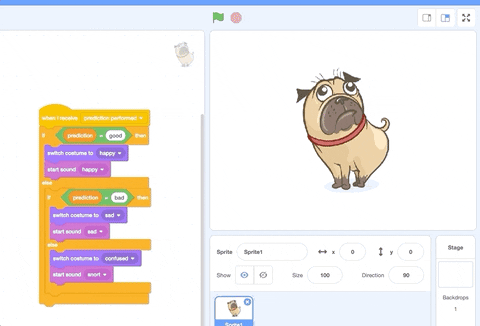
Source:http://cognimates.me/projects/goodBoy
Platform/Tool: Cognimates
20) Smart Vacuum Cleaner (14 years and above)
Learn how to make a smart vacuum cleaner! You can build upon the robot with Google Teachable Machine to help it recognise things it shouldn't vaccuum (like your favourite minifigures!)
Source generated:https://circuitdigest.com/microcontroller-projects/build-your-own-arduino-based-smart-vacuum-cleaning-robot-for-automatic-floor-cleaning
Platform/Tool: Arduino + Google Teachable Machine
21) Nature Explorer (11 years and above)
With AIY, beginners are able to get hands-on experience while learning about artificial intelligence. A typical kit consists of a cardboard box, a robot, instructions, a tripod stand, a speaker or lens, and a vision bonnet. They can all be connected with other peripheral devices as well.
You can bring your model to scan insects/plants and have your machine help you figure out the name of the insect/plant.

Source:https://aiyprojects.withgoogle.com/model/nature-explorer/
Platform/Tool: Google AIY Vision Kit
22) Check Mood of Tweets (11 years and above)
A free, open-source AI learning platform for children starting at age 7. Using games, robots, and AI training, children can learn how to make games and robots. There is a library of tools and activities for learning AI. This platform gives children the opportunity to program intelligent devices like Alexa.
You can use text recognition functions to scan tweets and figure out what mood the tweeter was conveying!
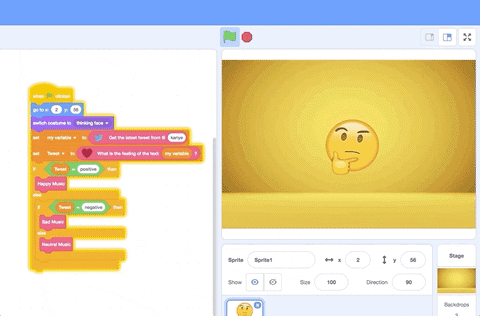
Source:http://cognimates.me/projects/twitter
Platform/Tool: Cognimates
23) AI Tic-Tac-Toe (15 years and above)
Almost everyone who plays Tic-Tac-Toe or Crosses enjoys it. This relatively simple game attracts artificial intelligence programs and has been solved by algorithms like Minimax, Depth-First Search, and Monte-Carlo Tree Search because of its relative simplicity.
Source: https://www.youtube.com/watch?v=itEgZPVuCq0&ab_channel=JustFinishedCoding%21
As a result of this series, you will use a slightly different algorithm, but you will still obtain the desired result. In addition to the graphical interface, the program would have multiple animations, and an unbeatable AI.
Platform/Tool: Scratch 3.0
24) Human Tetris Game (15 years and above)
How about we go back to old school? Try an create an AI that can win a Tetris game!
Source: https://www.youtube.com/watch?v=kpT3kA0Xj2E&ab_channel=JacobLichtefeld
25) Make Me Happy (6 to 10 years old)

Source: https://machinelearningforkids.co.uk/#!/worksheets
Create a character that smiles when you say nice things to it and cries when you say mean things to it in Scratch.
Platform/Tool: Scratch 3.0
26) Height Tracker (15 years old and above)
In this activity, students will learn how to perform object measurement known as Height Tracker. No rulers? That's right!
Source:https://www.youtube.com/watch?v=tk9war7_y0Q&ab_channel=Murtaza%27sWorkshop-RoboticsandAI
Platform/Tool: OpenCV
27) Smart Classroom (6 to 10 years old)

Source: https://machinelearningforkids.co.uk/#!/worksheets
Use Scratch to create a smart assistant that controls your virtual devices. The computer will learn what you mean when you speak! You can control devices in your classroom.
Platform/Tool: Scratch 3.0
28) Snap! (6 to 10 years old)
In Scratch, you can make a card game that learns to recognize cards' pictures. Use icons to teach the computer what they represent.

Source:https://machinelearningforkids.co.uk/#!/worksheets
Platform/Tool: Scratch 3.0
29) Chameleon (6 to 10 years)
With scratch, you can create chameleons that change color to match their environment. Computers can be taught to recognize colors using Scratch

Source generated:https://machinelearningforkids.co.uk/#!/worksheets
Platform/Tool: Scratch 3.0
30) Quiz Show (10 years and above)
Find answers in documents using a computer that has been trained to do so! You can create a game show player that can answer questions about any topic you want.

Source generated:https://machinelearningforkids.co.uk/#!/worksheets
Platform/Tool: Scratch 3.0
31) Describe the Glass (6 to 10 years)
In Scratch, create a game that learns when you describe a glass as half-full or half-empty and let computers predict your answers!

Source:https://machinelearningforkids.co.uk/#!/worksheets
Platform/Tool: Scratch 3.0
32) Titanic (15 years old and above)
Using Python, make a program that predicts who survived the sinking of the Titanic by making a computer capable of making predictions!

Source generated:https://towardsdatascience.com/predicting-the-survival-of-titanic-passengers-30870ccc7e8
Platform/Tool: Python
33) Mailman Max (6 to 10 years old)
Scratch can recognize handwritten postcodes on envelopes and create a postal sorting office. Computers can be taught to recognize handwriting!

Source generated:https://machinelearningforkids.co.uk/#!/worksheets
Platform/Tool: Scratch 3.0
34) Shoot the Bug (6 to 10 years old)
Develop Scratch code that allows players to learn the angle from which to shoot balls in Breakout-style arcade games. Teach a computer to play a game!

Source generated:https://machinelearningforkids.co.uk/#!/worksheets
Platform/Tool: Scratch 3.0
35) Machine Zines (6 to 10 years old)
Love storytelling? Make a zine from just an A4 size paper! Use code to position the pages accurately.
Source generated:https://zine-machine.glitch.me/
Platform/Tool: Glitch
36) Emojify My Face (10 years and above)
This project centers on recognizing human facial expressions, classifying them and mapping them to emojis. You will build a convolutional neural network to recognise facial emotions, and then map them to emojis or avatars.

Source:https://data-flair.training/blogs/create-emoji-with-deep-learning/
Platform/Tool: OpenCV
37) Journey to School (10 years old and above)
Create a program that can predict your morning commute to school. Teach the computer to make predictions.

Source:https://machinelearningforkids.co.uk/#!/worksheets
Platform/Tool: Scratch 3.0
38) Mask Up! (6 to 10 years old)
The pandemic got us all masked up. So what's a better way to learn than to relate it to today's norm!
Source:https://www.youtube.com/watch?v=OP7c3swgpCs&ab_channel=MakerLearners
Platform/Tool: Google Teachable Machine
39) Rock, Paper, Scissors! (6 to 10 years old)
Ever wondered how rock-paper-scissors can be played even through the involvement of AI and ML? We got one for you!
Source generated: https://www.youtube.com/watch?v=WAGP4aKZ5r8&ab_channel=dh.artisan
Platform/Tool: Machinelearningforkids.uk
40) Music with Hand Gesture (6 to 10 years old)
In this activity, you'll be able to build a virtual xylophone. How cool is that?
Source: https://www.youtube.com/watch?v=LlWpNDSGXgs&ab_channel=RSJunction
The xylophone keys can be played with the tip of an index finger by using PictoBlox's human body detection extension.
Platform/Tool: PictoBlox
41) LEGO Parts Sorter (10 years old and above)
A DIY experiment connecting Arduino + Teachable Machine
Source generated: https://www.youtube.com/watch?v=lD4nwMomrF0&ab_channel=ExperimentswithGoogle
You can learn about machine learning and physical computing using the Tiny Sorter project, a fun starter project!
Platform/Tool: Google Teachable Machine + Arduino
42) Shy Panda (10 years old and above)
Teach a computer to recognize webcam pictures.

Source:https://machinelearningforkids.co.uk/#!/worksheets
Create a dancing panda that will stop dancing if it sees you looking at it!
Platform/Tool: Scratch 3.0
43) Fooled (10 years old and above)
Understand how computers can become confused and make mistakes if they're not properly trained by making a computer recognize fruits.

Source:https://machinelearningforkids.co.uk/#!/worksheets
Platform/Tool: Scratch 3.0
44) Top Trumps (10 years old and above)
Use Scratch to teach a computer the Top Trumps card game, teach a computer to play a game!

Source:https://machinelearningforkids.co.uk/#!/worksheets
Platform/Tool: Scratch 3.0
45) Alien Language (10 years old and above)
Create a Scratch alien that can recognize foreign languages. Teach a computer to recognize sounds.

Source generated:https://machinelearningforkids.co.uk/#!/worksheets
Platform/Tool: Scratch 3.0
46) Pac-Man (10 years and above)
Teach a computer to play a game by creating a Pacman game in Scratch that avoids ghosts !

Source generated:https://machinelearningforkids.co.uk/#!/worksheets
Platform/Tool: Scratch 3.0
47) Zombie Escape! (10 years old and above)
Create a computer that can predict ahead of time and help you escape from the zombie horde ! Ready for the challenge?

Source generated:https://machinelearningforkids.co.uk/#!/worksheets
Platform/Tool: Scratch 3.0
48) Tourist Info (14 years old and above)
Using Scratch, develop a mobile app that recommends tourist attractions based on people's interests. Teach the computer to make recommendations.

Source generated:https://machinelearningforkids.co.uk/#!/worksheets
Platform/Tool: Scratch 3.0
49) Ink Blots (10 years old and above)
Learn about the news coverage of AI by recreating an MIT research project. Teach a computer to recognize images of objects.

Source generated:https://machinelearningforkids.co.uk/#!/worksheets
Platform/Tool: Scratch 3.0
50) Sorting Hat (10 years old and above)
Program a computer to recognize language usage. In addition, like Harry Potter, set up a Sorting Hat that sorts you into a school House based on your answers!

Source generated:https://machinelearningforkids.co.uk/#!/worksheets
Platform/Tool: Scratch 3.0
Did we miss out on any cool projects? Leave a comment or drop us an email at learn@ducklearning.com!



